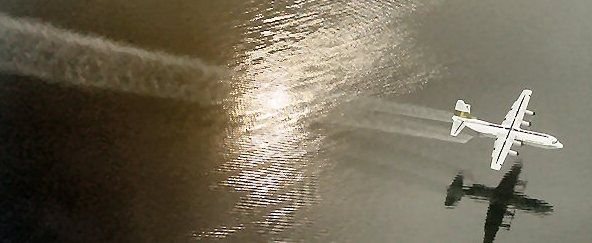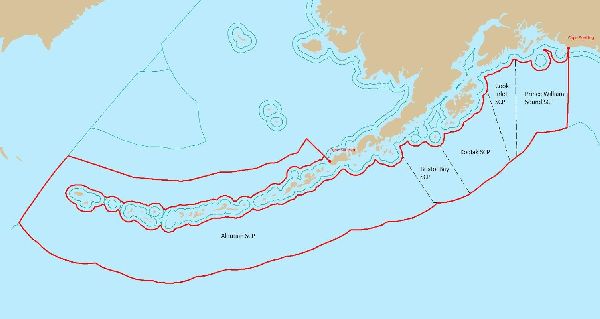Oil Dispersant Guidelines: Unified Plan, Annex F, Appendix I

2013-2014 Preauthorization Guideline Update Process
In 2013, in accordance with the National Oil and Hazardous Substances Pollution Contingency Plan – Subpart J (Section 300.910), Alaska Regional Response Team (ARRT) representatives from the Alaska Department of Environmental Conservation, US Coast Guard, Environmental Protection Agency, Department of Commerce, and the Department of Interior began an effort to update the Dispersant Use Plan for Alaska for the first time since 1989.
The effort culminated in significant changes to the Dispersant Use Plan, including:
- Defining the preauthorization area (see Figure 1), i.e. the area in which the US Coast Guard’s Federal On-Scene Coordinator (FOSC) is authorized to approve dispersant use after coordination with other members of the Alaska Regional Response Team, federally recognized tribes, and stakeholders.
- Defining “case-by-case” areas where the decision to use dispersants requires approval from the Environmental Protection Agency’s FOSC, US Coast Guard’s FOSC, and the Alaska Department of Environmental Conservation’s State On-Scene Coordinator when state waters are threatened, with input from members of the Alaska Regional Response Team, Department of Interior, and Department of Commerce.
- Requiring companies shipping crude oil to stockpile dispersants in Alaska and be able to use them within seven hours following an “approval for use” decision.
- Outlining procedures for stakeholders, including federally recognized tribes, to identify “avoidance areas” (i.e. areas within the preauthorization area where dispersant use should be considered on a case-by-case basis).
- Describing the process for approving, testing, evaluating, monitoring, and reporting dispersant use. NOTE: Preauthorization is not the same as “pre-approval.” Preauthorization merely streamlines the review and approval processes for dispersant use requests.
Between November 2013 and February 2014, public outreach sessions garnered nearly 700 comments on the draft plan. Following consideration of individual comments, the updated guidelines were signed and enacted on January 27, 2016. These guidelines were immediately in effect and incorporated into Annex F (Non-mechanical Response Guidelines) of the Unified Plan. This initiated a 24 month window, during which OSCs sought public input to identify dispersant avoidance areas.

Figure 1. The preauthorization area (shown in red) begins 24 miles offshore and extends southward to the Exclusive Economic Zone, located 200 miles offshore, and 100 miles north of the Aleutian Chain. Two anchor points, located at Cape Suckling and Cape Sarichef, ensure all vessels entering Southcentral Alaska from the south, and traffic using the Great Circle route through Unimak Pass are subject to these dispersant preauthorization requirements.
2017 Avoidance Area - Public Outreach Identification
An Interagency Technical Committee convened to seek public input on potential avoidance areas. The Technical Committee analyzed this input and consulted subject matter experts before nominating avoidance areas to On-Scene Coordinators. The committee is composed of biologists, toxicologists, and other subject-matter experts from the Department of the Interior, the U.S. Fish and Wildlife Service, the National Oceanic and Atmospheric Administration, the National Marine Fisheries Service, the United States Coast Guard, the Alaska Department of Fish and Game, the Alaska Department of Environmental Conservation, and the U.S. Geological Survey.
Public comments were solicited during five meetings including:
- Cook Inlet Subarea - Kenai City Council Chambers - November 10, 2016;
- Prince William Sound Subarea - Valdez Civic Center - November 16, 2016;
- Kodiak Subarea - Kodiak Borough Conference Room - November 29, 2016;
- Aleutians Subarea – City of Unalaska Council Chambers - December 8, 2016; and
- Bureau of Indian Affairs Providers’ Conference - Dena’ina Civic and Convention Center (Anchorage) - November 30 –December 1, 2016.
Approximately 120 comments were received during the public comment period, and the Technical Committee addressed individual comments before briefing OSCs on their consensus recommendation in August 2017. After receiving OSC endorsement, the Technical Committee then wrote new sections for the five subarea contingency plans containing a portion of the preauthorization area (i.e. Prince William Sound, Cook Inlet, Kodiak, Bristol Bay, and the Aleutians; see left column). The public comment period for these new annexes ran from October to December 2017.
Case-by-case decision-making protocols apply to the following area designations (see Figure 2):
- Undesignated Areas span between the shoreline and the 24nm U.S. Contiguous Zone or the 1,000m isobath, whichever is further seaward.
- The following types of information were analyzed to determine potential vulnerability to dispersed oil before avoidance areas were determined: Essential Fish Habitat; Habitat Areas of Particular Concern (HAPC); seasonality of primary and secondary productivity; fishery stock assessments and commercial fishery harvest data; short-tailed albatross (endangered species) concentration areas and distribution; Audubon’s Important Bird Areas; Endangered Species Act-listed threatened and endangered species and their critical habitat; cetacean Biologically Important Areas in Alaska1; physical oceanography parameters (e.g., bathymetry, sediment loading, salinity gradients, kinetic energy and mixing rates, settling rates, benches, troughs, navigational entrances, etc.); hydrographic flow patterns (e.g., lateral, vertical, stratification, upwelling, and seasonal variations); areas of public concern; and other scientific information.

Figure 2. Avoidance Area Designations.
For More Information
- For additional information regarding the Dispersant Use Preauthorization Guidelines, the Dispersant Use Avoidance Areas, or to submit comments, please contact: dec.spar.dispersants@alaska.gov

 Indicates an external site.
Indicates an external site.